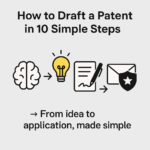 In the world of innovation, protecting your intellectual property is crucial. A well-drafted patent can be the key to securing exclusive rights to your invention and ensuring its commercial success. However, writing a patent application requires careful attention to legal and technical details.
In the world of innovation, protecting your intellectual property is crucial. A well-drafted patent can be the key to securing exclusive rights to your invention and ensuring its commercial success. However, writing a patent application requires careful attention to legal and technical details.
In this blog, we break down how to draft a patent in 10 simple steps, helping you create a strong application that meets legal requirements and protects your invention effectively.
1. Title: Define Your Invention Clearly
Your patent title should be concise and descriptive, summarizing the nature and subject of your invention in 15 words or fewer. A clear title helps examiners and potential investors understand your invention at a glance.
✅ Example: “A Smart Irrigation System for Water Conservation in Agriculture”
2. Technical Field: Establish the Scope
The technical field defines where your invention fits within existing technology. It provides clarity on the subject matter and how it is classified under patent law.
✅ Key Points to Include:
- Scope and Subject Matter of the invention
- The nature of the invention (e.g., software, mechanical device, medical device)
- How it relates to existing technology classifications
- Example phrasing: “The disclosure relates to an automated irrigation system designed for optimizing water usage in large-scale farms.”
3. Background: Identify the Problem
The background section lays the foundation for why your invention is necessary. Here, you should describe:
- What existing solutions are available
- Problems with current technology
- Gaps in prior inventions that your idea addresses
- Differentiate invention from inventions
✅ Example: If you are patenting a new smartphone battery, explain why existing batteries have short lifespans or overheating issues.
4. Object: The Solution Your Invention Provides
Now that you’ve identified the problem, clearly state the solution your invention offers.
✅ Example: “Disclosed embodiments show a battery that maintains a stable temperature, extends battery life, and improves charging efficiency.”
5. Statement of the Invention: Define the Novelty
This section summarizes the inventive concept in a straightforward manner. It should highlight the key novel feature and how it improves upon prior art.
✅ Example: “The disclosure introduces a graphene-based battery that significantly enhances energy retention and thermal management, reducing overheating risks.”
6. Summary: Provide an Overview
This section provides a structured and broad summary of your invention. It should:
- Give a high-level understanding of the invention
- Describe the problems solved
- Highlight the advantages it offers over existing solutions
✅ Example: “Unlike conventional lithium-ion batteries, disclosed embodiments of the graphene-based battery extends lifespan by 50% while maintaining optimal temperature regulation, making it ideal for high-performance electronic devices.”
7. Brief Description of Drawings
If your invention includes drawings (which most patents do), you need to describe them clearly in this section.
✅ Include:
- Reference numbers corresponding to drawing elements
- A description of specific components and their relationships
- Phrasing examples:
- “Figure 1 illustrates a cross-sectional view of the battery structure.”
- “Figure 2 shows a detailed schematic of the thermal regulation mechanism.”
8. Detailed Description: How It Works
This is the a critical section of your patent application, explaining:
- What the invention is
- How it is made (with examples)
- How it works (explaining technical processes)
- How it is used in real-world applications
- Drawings (if applicable)
✅ Example Structure for a Smart Battery Patent:
- Materials used: Graphene, lithium-polymer compounds
- Manufacturing process: Step-by-step explanation of how the battery is built
- How it improves performance: Comparison with traditional batteries
9. Claims: Define the Legal Protection
The claims section determines the legal protection your patent provides.
Types of Claims:
- Independent Claims: Define the main protection of the invention.
- Dependent Claims: Add specific details or refinements to independent claims.
✅ Example Claim: “A rechargeable battery comprising: a graphene-based anode, a lithium-polymer cathode, and a thermal regulation circuit, wherein the battery maintains a temperature under one-hundred degrees fahrenheit during operation.”
10. Abstract: A Concise Summary
The abstract is a 150-word summary that highlights:
- Technical field
- Core functionality
- Key problems solved
✅ Example Abstract: “The disclosure relates to a graphene-based battery designed for high-performance electronic devices. It enhances battery life, prevents overheating, and ensures efficient energy usage. The innovative thermal regulation system improves safety and extends device usability.”
Crafting a Strong Patent Application
A well-drafted patent application is essential for securing your intellectual property rights and preventing competitors from copying your invention. By following these 10 key steps, you ensure your patent is detailed, legally robust, and provides maximum protection.




